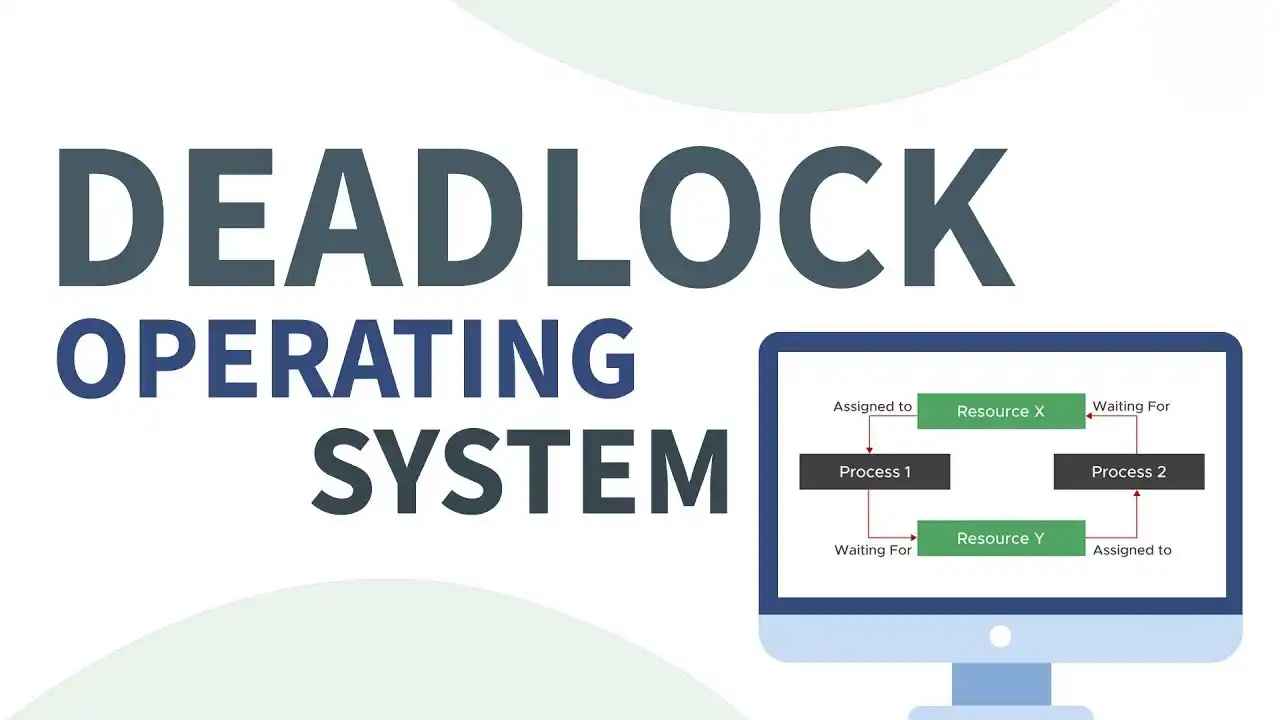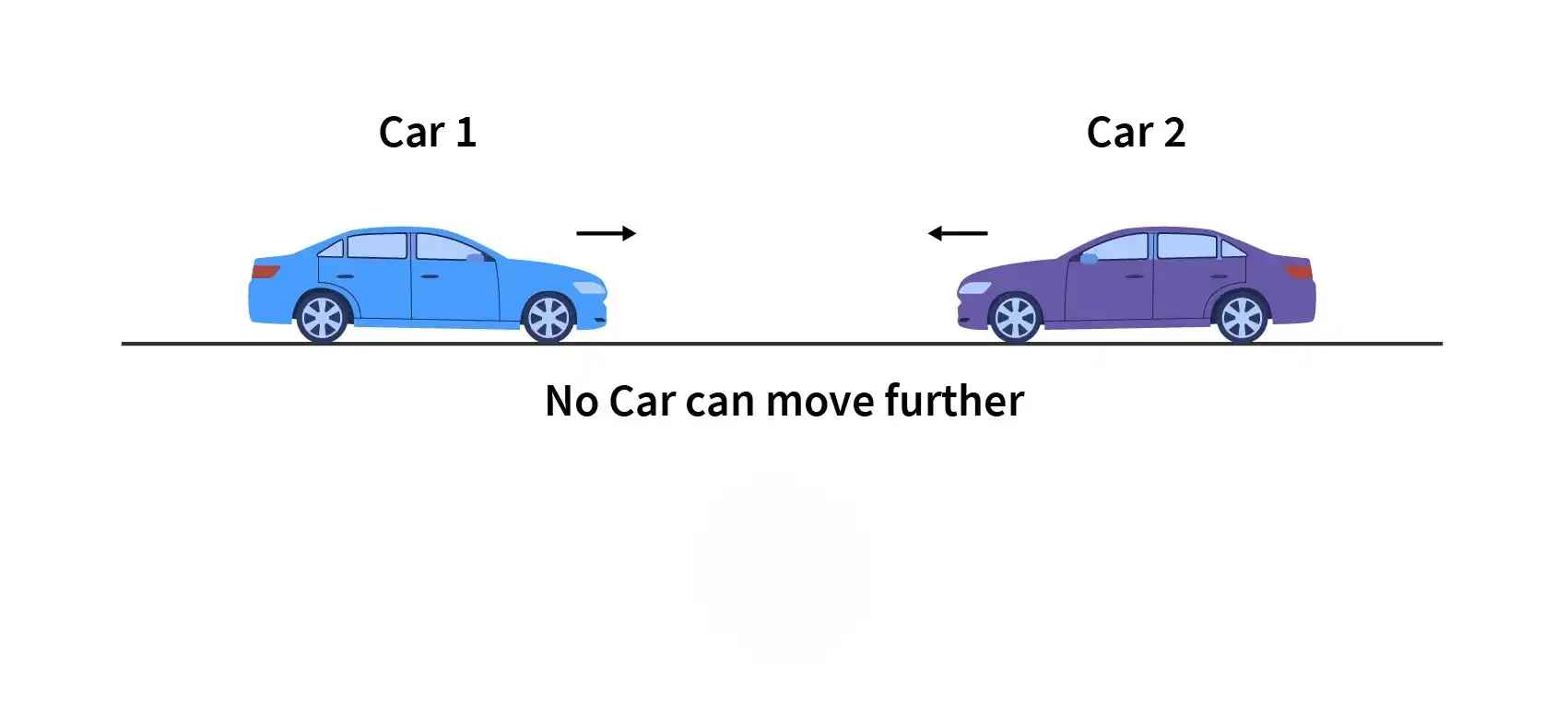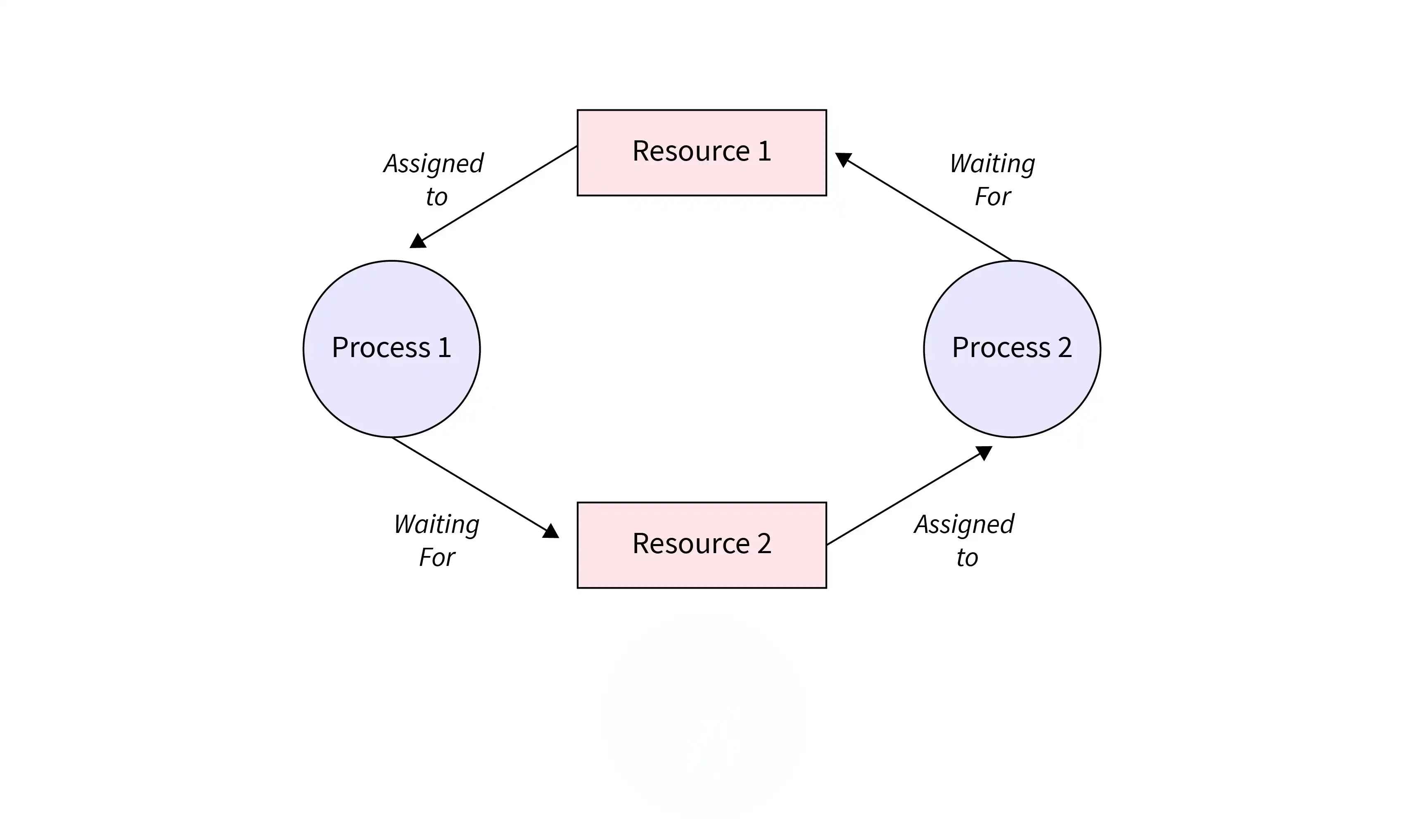Deadlock: processes wait forever for each others resources
Updated on : 17 April 2025

Image Source: google.com
Table Of Contents
- 1. Introduction
- 2. Deadlock in OS
- 3. Necessary Conditions for Deadlock
- 4. Deadlock Detection
- 5. Deadlock Prevention Techniques
- 6. Deadlock Avoidance Techniques
- 7. Deadlock Recovery Methods
- 8. Deadlock Handling Strategies
- 9. Difference Between Deadlock and Starvation
- 10. Starvation: Causes and Solutions
- 11. Advantages and Disadvantages of Deadlock Handling
- 12. Conclusion
- 13. FAQs
Table Of Contents
Introduction
In operating systems, a deadlock is like a traffic jam where every car 🚗 waits for another to move, but no one ever does! 😵 Multiple processes get stuck, each waiting for resources held by others. This freeze 🧊 can crash performance if not handled. ⚠️
Deadlock in OS

Image Source: google
- 🔄 What is Deadlock?
- A situation where processes get stuck, each waiting for a resource held by another. No one can proceed.
- 🧩 Necessary Conditions
- Mutual Exclusion
- Hold and Wait
- No Preemption
- Circular Wait
- 🔍 Deadlock Detection
- The system checks for cycles in resource allocation to spot deadlocks.
- 🛡️ Deadlock Prevention
- Ensure at least one of the necessary conditions doesn’t hold.
- 🚦 Deadlock Avoidance
- Use algorithms like Banker’s Algorithm to avoid unsafe states.
- 🔁 Deadlock Recovery
- Choose a victim process and terminate or roll back to break the deadlock.
- ⚖️ Deadlock vs Starvation
- Deadlock: processes wait forever.
- Starvation: some processes may never get resources due to others' priority.
- ✅ Pros & Cons
- Helps understand system behavior.
- Can reduce performance and cause system hangs.
- 🔚 Conclusion
- Proper handling is crucial to maintain system reliability and performance.

Looking to integrate mobile app solutions into your business?
Necessary Conditions for Deadlock
| 🔑 Condition | 📝 Description |
|---|---|
| Mutual Exclusion | Only one process can use a resource at a time |
| Hold and Wait | Process holds one resource, waits for another |
| No Preemption | Resources can't be forcibly taken away |
| Circular Wait | Processes form a circular chain, each waiting |
Deadlock Detection
| 🔍 Aspect | 📝 Description |
|---|---|
| What it is | Checks system for deadlocks after they occur |
| How it works | Uses Resource Allocation Graph or detection algorithms |
| When to use | When deadlocks are rare but possible |
| Requirement | System must track all resource allocations |
| Action | Identifies and resolves by aborting/rolling back processes |
Deadlock Prevention Techniques

Image Source: google
- Mutual Exclusion
- What it means: A resource can be used by only one process at a time.
- How to prevent: Try to make resources shareable.
- Problem: Not possible for all resources (like printers).
- Hold and Wait
- What it means: A process holds one resource and waits for more.
- How to prevent:
- Ask all needed resources at once.
- Or release held resources before asking for new ones.
- Problem: Wastes resources and causes delays.
- No Preemption
- What it means: Resources can't be taken from a process.
- How to prevent: Allow taking back resources if needed.
- Problem: Not always safe or possible for some resources.
- Circular Wait
- What it means: A cycle where each process waits for a resource held by the next.
- How to prevent:
- Set a fixed order to request resources.
- Processes must request in that order.
- Problem: Makes system less flexible.
Deadlock Avoidance Techniques
| 🛡️ Technique | 📝 Description |
|---|---|
| Safe State Checking | System only proceeds if it stays in a safe state |
| Banker's Algorithm | Allocates resources safely by simulating future requests |
| Resource Allocation Graph (RAG) | Tracks resource usage and avoids circular waits |
| Advance Resource Request | Processes must request all needed resources upfront |
Deadlock Recovery Methods
| 🔁 Recovery Method | 📝 Description |
|---|---|
| Process Termination | Abort one or more processes to break the deadlock |
| Resource Preemption | Forcefully take resources from processes |
| Rollback | Rollback a process to a safe state and restart it |
| Process Restart | Terminate and restart affected processes from scratch |

Got a stellar idea ready to turn into powerful software?
Deadlock Handling Strategies
- 🔍 Deadlock Detection and Recovery
- Let the system enter deadlock, then detect and recover.
- Suitable when deadlocks are rare.
- 🛑 Deadlock Prevention
- Design system to avoid one or more necessary conditions for deadlock.
- Example: don’t allow hold and wait.
- 🛡️ Deadlock Avoidance
- System checks in advance if a request might lead to deadlock.
- Uses techniques like Banker's Algorithm.
- 🚫 Ignore the Problem (Ostrich Approach)
- Assume deadlock won’t happen; don’t handle it.
- Used in systems where deadlocks are very rare (e.g., some UNIX systems).
Difference Between Deadlock and Starvation

Image Source: google
| ⚖️ Aspect | 🔒 Deadlock | 🥺 Starvation |
|---|---|---|
| Definition | Processes wait forever for each other's resources | A process waits indefinitely due to low priority |
| Cause | Circular wait and resource holding | Unfair resource allocation |
| Process Progress | No process progresses | Some processes continue, others don’t |
| Detection | Can be detected and recovered | Harder to detect |
| Resolution | Needs recovery methods | Can be solved by fair scheduling |
Starvation: Causes and Solutions
⚠️ Causes of Starvation
- 🔁 Biased Scheduling Algorithms
- Some algorithms favor high-priority processes.
- Low-priority processes may never get a chance to execute.
- 🔝 Continuous Arrival of High-Priority Tasks
- If the system always receives high-priority tasks, lower-priority ones get pushed back indefinitely.
- 🔒 Resource Locking
- When resources are always occupied by other processes, some may keep waiting.
- 🚫 No Aging Mechanism
- Without increasing the priority of waiting processes over time, they may starve.
- 🔄 Improper Resource Allocation
- Resource allocation not considering fairness can cause repeated denial of access.
✅ Solutions to Starvation
- ⏫ Aging Technique
- Gradually increase the priority of waiting processes to ensure they eventually get CPU time.
- ⚖️ Fair Scheduling Algorithms
- Use fair schedulers like Round Robin or Fair Share Scheduling to distribute CPU evenly.
- ⛔ Limit Priority Inversion
- Prevent high-priority tasks from blocking lower ones forever by using priority inheritance.
- 🧠 Smart Resource Allocation Policies
- Design resource handling with fairness and guaranteed access in mind.
- 📊 Monitoring & Feedback Systems
- Regularly monitor system behavior and adjust priorities or resource distribution dynamically.
Advantages and Disadvantages of Deadlock Handling
| ✅ Advantages | ❌ Disadvantages |
|---|---|
| Ensures system stability by handling deadlocks proactively | Increases system complexity and overhead |
| Improves resource utilization when handled properly | Can reduce performance due to constant checks or constraints |
| Allows recovery from rare deadlock situations | Recovery may lead to data loss or process termination |
| Deadlock avoidance techniques prevent unsafe states | Requires prior knowledge of maximum resource needs |
| Deadlock handling increases system reliability | Implementation of algorithms like Banker's is complex |
| Flexible strategies (prevention, detection, avoidance) | Some strategies (e.g., prevention) can be too restrictive |
Conclusion

Image Source: google
- Nature of Deadlock
- Deadlock occurs when processes are indefinitely waiting for resources held by each other.
- It leads to system freeze and poor resource utilization.
- Need for Handling
- Ignoring deadlocks can result in degraded system performance and user dissatisfaction.
- Efficient handling is necessary in critical and real-time systems.
- Strategies Available
- Prevention: Design system to eliminate one or more necessary conditions for deadlock.
- Avoidance: Use algorithms like Banker's Algorithm to stay in safe states.
- Detection and Recovery: Allow deadlocks but detect and recover when they occur.
- Ignore (Ostrich Method): Used where deadlocks are rare and minimal impact is expected.
- Choosing the Right Approach
- Depends on system type, application requirements, and expected deadlock frequency.
- Balance between performance, complexity, and safety is crucial.
- Overall Importance
- Mastery of deadlock concepts helps in designing better operating systems.
- Ensures system reliability, efficiency, and optimal resource use.
FAQs
Q.1. What is a deadlock in operating systems?
A : A deadlock is a situation where two or more processes are stuck waiting for each other’s resources, and none can proceed.
Q.2. What causes a deadlock?
Deadlocks occur when the following four conditions hold simultaneously:
A : Mutual Exclusion
A: Hold and Wait
A : No Preemption
A : Circular Wait
Q.3. How is deadlock different from starvation?
A : In deadlock, all involved processes are blocked indefinitely.
A : In starvation, a process waits too long due to low priority but others may continue.
Q.4. Can deadlocks be prevented?
A : Yes. Deadlocks can be prevented by breaking one of the four necessary conditions using system design strategies.
Q.5. What is deadlock detection?
A : Deadlock detection involves monitoring resource allocation to identify cycles or blockages, and then taking steps to resolve them.
Q.6. What is the Banker's Algorithm?
A : Its a deadlock avoidance algorithm that allocates resources only if the system remains in a safe state after allocation.
Q.7. What are some ways to recover from a deadlock?
A : Terminate one or more processes.
A : Rollback a process to a safe state.
A : Preempt resources and assign them elsewhere.
Q.8. Is deadlock handling always necessary?
A : Not always. In some systems where deadlocks are rare or have low impact, developers may choose to ignore them.
Q.9. Can deadlocks happen in real life?
A : Yes. Deadlocks can occur in database systems, network traffic, and even daily scenarios like two people holding doors waiting for each other.
Q.10. Why is deadlock a problem?
A : Deadlocks waste system resources, reduce performance, and can cause system crashes if not resolved.


